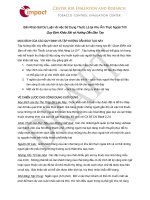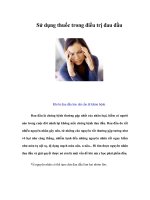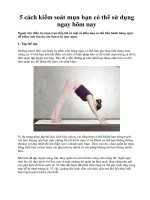language focus 15 su dung ngay
Bạn đang xem bản rút gọn của tài liệu. Xem và tải ngay bản đầy đủ của tài liệu tại đây (119.4 KB, 3 trang )
<span class='text_page_counter'>(1)</span><div class='page_container' data-page=1>
Teacher
Teacher: Dinh Tran Hoang Tuyen Vinh Trach High School - Lesson plan - grade 10
Period:
<b>Lesson 5: Language Focus</b>
<b>I.OBJECTIVES </b>: By the end of the lesson, students will be able to:
pronounce the sounds / θ / and / đ / exactly
remember the use of Adverb Clauses of Concession., Non-defining and
defining relative clauses
<b>II. PREPARATION</b>:<b> </b> Pictures, poster, handout, books…
<b>III.PROCEDUCE: </b>
<b>Time</b> <b>Contents</b> <b>T’s & Ss’ activities</b>
<b>4’</b>
<b>10’</b>
<b>I-Warmer : Kim’s game</b>
<b> think they brother something</b>
<b> birthday then mouth</b>
<b> Grammar and vocabulary</b> :
<b>A.</b> <i><b>Pronunciation :</b></i>
<i><b>Listen and repeat :</b> </i>
/ θ / / ð/
think
though
mouth
thin
something
birthday
they
those
then
clothes
another
brother
* /đ /
1. is the sound of TH: THIS, THERE, THEM…
2. TH in all position is always pronounced [đ] when there is the
vowel E after it. : FATHER, BREATHE, BATHE, CLOTHE….
VOWEL+ TH + VOWEL
[đ]
3. Singular nouns ending with TH when become plural nouns TH
[θ] must be changed into [đ]
MOUTH MOUTHS
BOOTH BOOTHS
PATH PATHS
* /θ / is the sound of TH it is not followed by the vowel E: PATH,
ETHNIC, NORTH
* Some changes in the pronunciation of compound nouns
SOU<b>TH </b> / θ / SOU<b>TH</b>- EAST /đ /
NOR<b>TH</b> / θ / NOR<b>TH</b>- EAST /đ /
<i><b>Practice these sentences</b></i> :
<b>1/</b> I thought Mr. Smith was thirty-three.
- T guides Ss how to
play a game
- Ss play the game
- T leads in the lesson
- T gives eliciting for
Ss to find out some
rules.
- T models and Ss
repeat in chorus.
- T reads aloud the
sound in each sentence.
Ss say number 1 with
the sound “/<b>θ</b> /” ;
number 2 with the
sound <b>“/</b>đ/”.
- Ss practice in 3’
(group work & pair
work)
</div>
<span class='text_page_counter'>(2)</span><div class='page_container' data-page=2>
Teacher
Teacher: Dinh Tran Hoang Tuyen Vinh Trach High School - Lesson plan - grade 10
<b>8’</b>
<b>10’</b>
<b>5’</b>
<b>2/</b> But next Thursday will be his thirtieth birthday
<b>3/</b> Something about him makes me think he is like my brother.
<b>4/</b> The roses that you gave him are beautiful.
<b>5/</b> Look at the clothes on that thin man over there.
<b>B. Grammar :</b>
<b>Non-defining and defining relative clauses.</b>
Example:
<i><b>-New York Harbour</b></i><b>, which is ice-free in all seasons, </b><i><b>is one of </b></i>
<i><b>the largest and finest habours in the world.</b></i>
<i><b>- The book </b></i><b>which I am going to lend you</b><i><b> is given to me by the </b></i>
<i><b>author.</b></i>
<b>-- > Notes: There are two kinds of Relative Clauses.</b>
* We use defining relative clauses to give <b>essential information</b> to
define or identify the thing we are talking about. Obviously, this is
only necessary if there is more than one thing involved.
* We use non-defining relative clauses <b>not to definite or identify </b>
<b>things but to add more information to the things</b> we are talking
about. Without this additional information, the sentence still makes
sense because it is already clear what things we are talking about.
<b>Exercise 1: </b><i><b>Underline the relative clauses in these sentences, and </b></i>
<i><b>indicate if they are defining (D) or non-defining (ND) . Add a </b></i>
<i><b>comma where required.</b></i>
1. Washington D.C. which is located on the East Coast of the United
States has many interesting and historical places to visit.
2. Brasilia which is located on the Grannadá River became the
capital of Brazil in 1960.
3. Mexico City which has a population of nearly 20,000,000 is the
largest metropolitan area in the world.
4. Seoul which hosted the 1988 Summer Olympics is well-known
for its shopping centres.
5. Kyoto which used to be the capital of Japan has many temples.
<b>Answer keys:</b>
All the relative clauses in this exercise are non-defining because
they serve to give additional information only.
1. Washington D.C., which is located on the East Coast of the
United States, has many interesting and historical places to visit.
2. Brasilia, which is located on the Grannadá River, became the
capital of Brazil in 1960.
3. Mexico City, which has a population of nearly 20,000,000, is the
largest metropolitan area in the world.
4. Seoul, which hosted the 1988 Summer Olympics, is well-known
for its shopping centres.
5. Kyoto, which used to be the capital of Japan, has many temples.
<b>Connecting contrasting ideas: ATHOUGH</b>
<b>Example: Although </b>New York is not the capital of the USA. It
is the home of the United Nations.
- T introduce the
grammar point through
eliciting from Ss
- T explains why we
call them non-defining
relative clauses.
- T gives more
examples
- T elicits the rules
from the students.
- T has Ss read the
sentences carefully then
discuss in order to
decide where the
relative clauses are.
- T explains the relative
clause carefully and ask
Ss to decide which
clauses are defining or
non defining clauses.
- Ss work alone to do
the task.
- T goes around to
control and collect Ss’
mistakes.
</div>
<span class='text_page_counter'>(3)</span><div class='page_container' data-page=3>
Teacher
Teacher: Dinh Tran Hoang Tuyen Vinh Trach High School - Lesson plan - grade 10
<b>7’</b>
<b>1’</b>
<b>Notes: </b>
+ Form: The subordinate clause with “although” can come either
before or after the main clause. Don’t use “although” together with
“but”.
+Meaning: in spite of the fact that
+Use: We use this conjunction to contrast ideas.
Although/ though + clause
Despite/ In spite of + noun phrase/ v-ing
Ex: I prefer living in the countryside although there is not much to
do there.
<b>Exercise 2</b>: <i><b>Combine the following sentences using ALTHOUGH</b></i>.
1. There is not much to do in the countryside. I prefer living in the
countryside.
2. There is a lot of pollution in Los Angeles. It is an ideal place to
live.
3. The shops are crowded. People are not buying much.
4. The city is a favourite tourist destination for many people. It has
its problems.
5. It is safe neighbourhood. It is best to be careful.
<b>Answer keys: </b>
1. Although there is not much to do in the countryside, I prefer
living in the countryside.
2. Although there is a lot of pollution in Los Angeles, it is an ideal
place to live.
3. Although the shops are crowded, people are not buying much.
4. Although the city is a favourite tourist destination for many
people, it has its problems.
5. Although it is safe neighbourhood, it is best to be careful.
<b>Homework : </b>Prepare new lesson: Reading Unit 16
- T has Ss read the
example.
- T explains why we
use the connector
ALTHOUGH.
- T asks Ss to do the
exercise 2
- Ss work alone to do
the task.
- T goes around to
control and collect Ss’
mistakes.
- T gives the correct
answers.
</div>
<!--links-->









